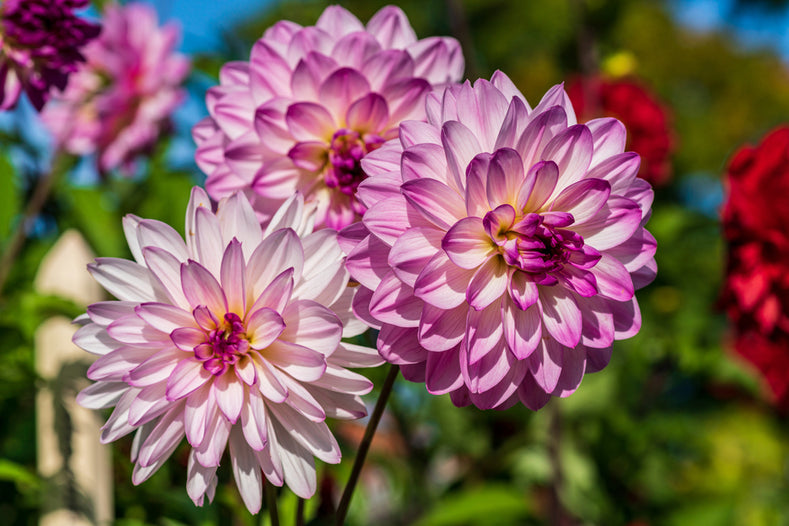No summer garden is complete without the stunning presence of dahlias. Originally hailing from Central America and Mexico, these bold and vibrant perennials are not only beautiful but also incredibly easy to plant and maintain. Whether you're a seasoned gardener or just starting out, you might be wondering how to grow dahlias, which varieties suit you best, and how to care for them during colder months.
Let's explore some of the fantastic dahlia varieties you can choose from, each offering a unique touch to your garden:
Single Dahlia: Understated yet captivating, single dahlias feature a layer of rounded or pointed petals surrounding a central ring. These charming flowers are not only aesthetically pleasing but also excellent at attracting pollinators, adding life and buzz to your garden.
Anemone Flowering Dahlia: Also known as Powder Puff Dahlias, these beauties boast distinctive double feathered petals. Anemone flowering dahlias have an unusual and eye-catching appearance that's sure to make a bold statement in your garden, drawing admiration from all who see them.
Cactus Dahlia: Among the most popular dahlia varieties, cactus dahlias sport double pointed petals that create a tube-shaped effect, earning them the nickname "Spiky Dahlias." With a range of sizes available, from miniature to giant, they bring a touch of uniqueness and drama to your garden.
Dark Leaf Dahlia: Standing apart from the crowd, dark leaf dahlias are known for their striking dark foliage, setting them apart from their bright green-leafed counterparts. If you're seeking to introduce some captivating contrast to your garden, this variety is an excellent choice.
Dwarf Dahlia: As the name suggests, dwarf dahlias are small in size but big on impact. Perfect for the front of garden borders and container planting, these little marvels bring a burst of colour and charm to any space they adorn.
Pompom Dahlia: With their delightful sphere-shaped petals that curve inward, pompom dahlias create charming circular flower heads. Available in a variety of colours, they offer a playful and joyful touch to your garden, radiating with vibrancy.
Now that you know about these mesmerising dahlia varieties, you can pick and choose the ones that best suit your garden and personal preferences. With their radiant hues and diverse forms, dahlias are sure to become the centrepiece of your summer garden, attracting admiration and adding a touch of magic to your outdoor space.

How to Plant:
- Once the winter frost has disappeared you can begin to dig holes approximately 10 cm and 39 cm apart in well-drained soil. As dahlias prefer a sunny location, try to find somewhere that receives plenty of sunlight throughout the day.
- Plant the dahlia tuber facing upwards with the tip of the tuber peering out of the soil.
- Water generously after covering the tuber with soil and then add a fertiliser every few weeks to help the dahlias grow during the summer months.
Planting dahlia tubers in pots and containers is very similar! When all signs of frost have disappeared, you can begin to plant your tubers in pots. We recommend adding some pebbles to the bottom of your pots to help with drainage. You can then add the compost and tubers to your pots and follow the same procedure as mentioned above.

Supporting the Plants: As dahlias grow, they can become top-heavy and may require support. Install stakes or cages around the plants when they are young to help them grow upright and prevent stem breakage later on.
Mulching: Apply a layer of organic mulch around the plants to retain moisture, suppress weeds, and regulate soil temperature. Pine straw, straw, or wood chips are good choices for mulching dahlias.
Fertilising: Dahlias are heavy feeders and benefit from regular fertilisation. Use a balanced, water-soluble fertiliser or a slow-release granular fertiliser to provide essential nutrients throughout the growing season. Follow the manufacturer's instructions for application rates.
Deadheading and Pruning: To encourage continuous flowering, remove spent blooms regularly. This process, known as deadheading, prompts the plant to produce more flowers. Additionally, you can pinch back the top of young plants when they reach about 12-18 inches to encourage bushier growth.


